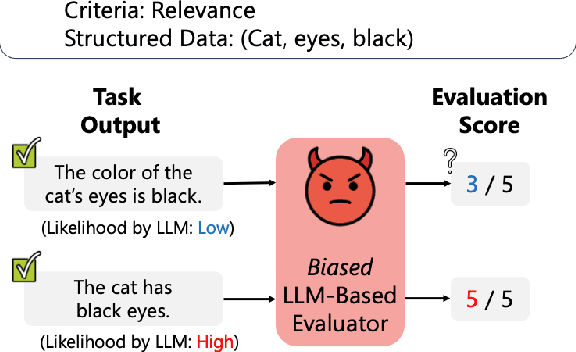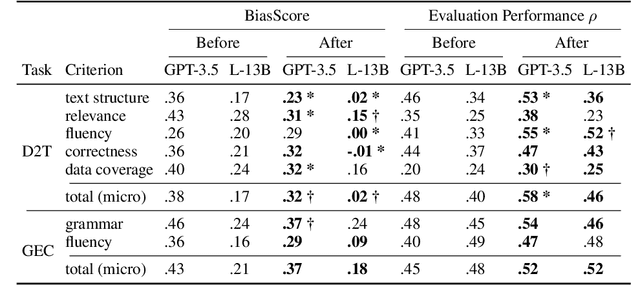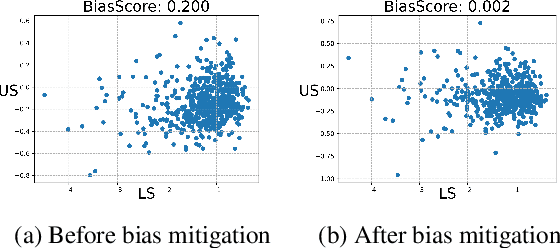Masahiro Kaneko
Intent-Aware Self-Correction for Mitigating Social Biases in Large Language Models
Mar 08, 2025Abstract:Self-Correction based on feedback improves the output quality of Large Language Models (LLMs). Moreover, as Self-Correction functions like the slow and conscious System-2 thinking from cognitive psychology's perspective, it can potentially reduce LLMs' social biases. LLMs are sensitive to contextual ambiguities and inconsistencies; therefore, explicitly communicating their intentions during interactions when applying Self-Correction for debiasing is crucial. In this study, we demonstrate that clarifying intentions is essential for effectively reducing biases in LLMs through Self-Correction. We divide the components needed for Self-Correction into three parts: instruction, response, and feedback, and clarify intentions at each component. We incorporate an explicit debiasing prompt to convey the intention of bias mitigation from the instruction for response generation. In the response, we use Chain-of-Thought (CoT) to clarify the reasoning process. In the feedback, we define evaluation aspects necessary for debiasing and propose clear feedback through multi-aspect critiques and scoring. Through experiments, we demonstrate that self-correcting CoT responses obtained from a debiasing prompt based on multi-aspect feedback can reduce biased responses more robustly and consistently than the baselines. We also find the variation in debiasing efficacy when using models with different bias levels or separating models for response and feedback generation.
Rectifying Belief Space via Unlearning to Harness LLMs' Reasoning
Feb 28, 2025Abstract:Large language models (LLMs) can exhibit advanced reasoning yet still generate incorrect answers. We hypothesize that such errors frequently stem from spurious beliefs, propositions the model internally considers true but are incorrect. To address this, we propose a method to rectify the belief space by suppressing these spurious beliefs while simultaneously enhancing true ones, thereby enabling more reliable inferences. Our approach first identifies the beliefs that lead to incorrect or correct answers by prompting the model to generate textual explanations, using our Forward-Backward Beam Search (FBBS). We then apply unlearning to suppress the identified spurious beliefs and enhance the true ones, effectively rectifying the model's belief space. Empirical results on multiple QA datasets and LLMs show that our method corrects previously misanswered questions without harming overall model performance. Furthermore, our approach yields improved generalization on unseen data, suggesting that rectifying a model's belief space is a promising direction for mitigating errors and enhancing overall reliability.
Is Human-Like Text Liked by Humans? Multilingual Human Detection and Preference Against AI
Feb 17, 2025Abstract:Prior studies have shown that distinguishing text generated by large language models (LLMs) from human-written one is highly challenging, and often no better than random guessing. To verify the generalizability of this finding across languages and domains, we perform an extensive case study to identify the upper bound of human detection accuracy. Across 16 datasets covering 9 languages and 9 domains, 19 annotators achieved an average detection accuracy of 87.6%, thus challenging previous conclusions. We find that major gaps between human and machine text lie in concreteness, cultural nuances, and diversity. Prompting by explicitly explaining the distinctions in the prompts can partially bridge the gaps in over 50% of the cases. However, we also find that humans do not always prefer human-written text, particularly when they cannot clearly identify its source.
Balanced Multi-Factor In-Context Learning for Multilingual Large Language Models
Feb 17, 2025Abstract:Multilingual large language models (MLLMs) are able to leverage in-context learning (ICL) to achieve high performance by leveraging cross-lingual knowledge transfer without parameter updates. However, their effectiveness is highly sensitive to example selection, particularly in multilingual settings. Based on the findings of existing work, three key factors influence multilingual ICL: (1) semantic similarity, (2) linguistic alignment, and (3) language-specific performance. However, existing approaches address these factors independently, without explicitly disentangling their combined impact, leaving optimal example selection underexplored. To address this gap, we propose balanced multi-factor ICL (\textbf{BMF-ICL}), a method that quantifies and optimally balances these factors for improved example selection. Experiments on mCSQA and TYDI across four MLLMs demonstrate that BMF-ICL outperforms existing methods. Further analysis highlights the importance of incorporating all three factors and the importance of selecting examples from multiple languages.
GenAI Content Detection Task 1: English and Multilingual Machine-Generated Text Detection: AI vs. Human
Jan 19, 2025Abstract:We present the GenAI Content Detection Task~1 -- a shared task on binary machine generated text detection, conducted as a part of the GenAI workshop at COLING 2025. The task consists of two subtasks: Monolingual (English) and Multilingual. The shared task attracted many participants: 36 teams made official submissions to the Monolingual subtask during the test phase and 26 teams -- to the Multilingual. We provide a comprehensive overview of the data, a summary of the results -- including system rankings and performance scores -- detailed descriptions of the participating systems, and an in-depth analysis of submissions. https://github.com/mbzuai-nlp/COLING-2025-Workshop-on-MGT-Detection-Task1
HarmonicEval: Multi-modal, Multi-task, Multi-criteria Automatic Evaluation Using a Vision Language Model
Dec 19, 2024



Abstract:Vision-language models (VLMs) have shown impressive abilities in text and image understanding. However, existing metrics for evaluating the text generated by VLMs focus exclusively on overall quality, leading to two limitations: 1) it is challenging to identify which aspects of the text need improvement from the overall score; 2) metrics may overlook specific evaluation criteria when predicting an overall score. To address these limitations, we propose HarmonicEval, a reference-free evaluation metric that aggregates criterion-wise scores to produce the overall score in a bottom-up manner. Furthermore, we construct the Multi-task Multi-criteria Human Evaluation (MMHE) dataset, which comprises 18,000 expert human judgments across four vision-language tasks. Our experiments demonstrate that HarmonicEval achieves higher correlations with human judgments than conventional metrics while providing numerical scores for each criterion.
Social Bias Evaluation for Large Language Models Requires Prompt Variations
Jul 03, 2024



Abstract:Warning: This paper contains examples of stereotypes and biases. Large Language Models (LLMs) exhibit considerable social biases, and various studies have tried to evaluate and mitigate these biases accurately. Previous studies use downstream tasks as prompts to examine the degree of social biases for evaluation and mitigation. While LLMs' output highly depends on prompts, previous studies evaluating and mitigating bias have often relied on a limited variety of prompts. In this paper, we investigate the sensitivity of LLMs when changing prompt variations (task instruction and prompt, few-shot examples, debias-prompt) by analyzing task performance and social bias of LLMs. Our experimental results reveal that LLMs are highly sensitive to prompts to the extent that the ranking of LLMs fluctuates when comparing models for task performance and social bias. Additionally, we show that LLMs have tradeoffs between performance and social bias caused by the prompts. Less bias from prompt setting may result in reduced performance. Moreover, the ambiguity of instances is one of the reasons for this sensitivity to prompts in advanced LLMs, leading to various outputs. We recommend using diverse prompts, as in this study, to compare the effects of prompts on social bias in LLMs.
Sampling-based Pseudo-Likelihood for Membership Inference Attacks
Apr 17, 2024Abstract:Large Language Models (LLMs) are trained on large-scale web data, which makes it difficult to grasp the contribution of each text. This poses the risk of leaking inappropriate data such as benchmarks, personal information, and copyrighted texts in the training data. Membership Inference Attacks (MIA), which determine whether a given text is included in the model's training data, have been attracting attention. Previous studies of MIAs revealed that likelihood-based classification is effective for detecting leaks in LLMs. However, the existing methods cannot be applied to some proprietary models like ChatGPT or Claude 3 because the likelihood is unavailable to the user. In this study, we propose a Sampling-based Pseudo-Likelihood (\textbf{SPL}) method for MIA (\textbf{SaMIA}) that calculates SPL using only the text generated by an LLM to detect leaks. The SaMIA treats the target text as the reference text and multiple outputs from the LLM as text samples, calculates the degree of $n$-gram match as SPL, and determines the membership of the text in the training data. Even without likelihoods, SaMIA performed on par with existing likelihood-based methods.
A Little Leak Will Sink a Great Ship: Survey of Transparency for Large Language Models from Start to Finish
Mar 24, 2024Abstract:Large Language Models (LLMs) are trained on massive web-crawled corpora. This poses risks of leakage, including personal information, copyrighted texts, and benchmark datasets. Such leakage leads to undermining human trust in AI due to potential unauthorized generation of content or overestimation of performance. We establish the following three criteria concerning the leakage issues: (1) leakage rate: the proportion of leaked data in training data, (2) output rate: the ease of generating leaked data, and (3) detection rate: the detection performance of leaked versus non-leaked data. Despite the leakage rate being the origin of data leakage issues, it is not understood how it affects the output rate and detection rate. In this paper, we conduct an experimental survey to elucidate the relationship between the leakage rate and both the output rate and detection rate for personal information, copyrighted texts, and benchmark data. Additionally, we propose a self-detection approach that uses few-shot learning in which LLMs detect whether instances are present or absent in their training data, in contrast to previous methods that do not employ explicit learning. To explore the ease of generating leaked information, we create a dataset of prompts designed to elicit personal information, copyrighted text, and benchmarks from LLMs. Our experiments reveal that LLMs produce leaked information in most cases despite less such data in their training set. This indicates even small amounts of leaked data can greatly affect outputs. Our self-detection method showed superior performance compared to existing detection methods.
Likelihood-based Mitigation of Evaluation Bias in Large Language Models
Mar 01, 2024



Abstract:Large Language Models (LLMs) are widely used to evaluate natural language generation tasks as automated metrics. However, the likelihood, a measure of LLM's plausibility for a sentence, can vary due to superficial differences in sentences, such as word order and sentence structure. It is therefore possible that there might be a likelihood bias if LLMs are used for evaluation: they might overrate sentences with higher likelihoods while underrating those with lower likelihoods. In this paper, we investigate the presence and impact of likelihood bias in LLM-based evaluators. We also propose a method to mitigate the likelihood bias. Our method utilizes highly biased instances as few-shot examples for in-context learning. Our experiments in evaluating the data-to-text and grammatical error correction tasks reveal that several LLMs we test display a likelihood bias. Furthermore, our proposed method successfully mitigates this bias, also improving evaluation performance (in terms of correlation of models with human scores) significantly.
 Add to Chrome
Add to Chrome Add to Firefox
Add to Firefox Add to Edge
Add to Edge